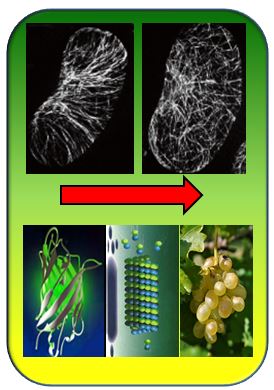2014_14 Illuminated Grapes
What is the topic?
The cytoskeleton (actin filaments and microtubules) are important for locomotion and shape of animal cells – plant cells do not move and their shape is maintained through a rigid cell wall. The cytoskeleton is thus free for new tasks. The plant cytoskeleton is emerging as sensory structure that can process external and internal signals. We, therefore, want to know, how the cytoskeleton behaves during the early phases of plant defence. Our plant of choice is Grapevine, because here microbial attacks cause tremendous damage. In frame of the Interreg-Network BACCHUS we investigate strategies to render viticulture more sustainable by exploiting the newest results from research. So far, to visualise the cytoskeleton in grapevine required to kill and permeabilise the cells. We have now developed an alternative, where we use the Green Fluorescent Protein (GFP) that cause the marine glow of certain jellyfishes. This protein is coupled tot he cytoskeleton and then we use spinning disc confocal laser scanning microscopy to follow the cytoskeletal response to a stimulus in living cells. Earlier this year we were able to publish this for actin (the cellular „muscles“), and we could show that these muscles contract, when spores of Downy Mildew attach to the stomata of leaves. Now, we deliver the second chapter – we were successful in generating a Grapevine cell line, where microtubules glow and we can now see, how microtubules form bundles in response to salt stress, a phenomenon that can be also evoked by addition of the stress hormone jasmonic acid.
Publication
110. Xin G, Buchholz G, Nick P (2015) Tubulin marker line of grapevine suspension cells as a tool to follow early stress responses. J Plant Phys 176, 118-128 - pdf

